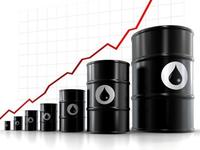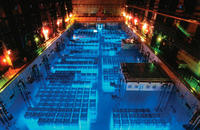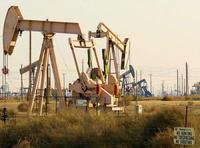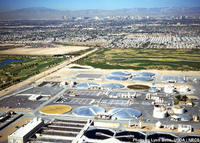-
Natural gas is good for the economy, environment
No matter how we drill it, using natural gas as an energy source is a smart move in the battle against global climate change and a good transition step on the road toward low-carbon energy from wind, solar, and nuclear power
-
-
A 10-year plan for Europe’s grid
A new study shows that 104 billion euro over ten years need to be invested in the refurbishment or construction of roughly 52,000 km of extra high voltage power lines and cables across Europe in order to add 3 percent generation capacity and the reliable integration of 125 GW of renewable energy sources
-
-
Forecast: sharp increase in world oil production capacity, risk of price collapse

Oil production capacity is surging in the United States and several other countries at such a fast pace that global oil output capacity is likely to grow by nearly 20 percent by 2020, which could prompt a plunge or even a collapse in oil prices; the growth in oil output owes largely to a combination of high oil prices and new technologies such as hydraulic fracturing that are opening up vast new areas and allowing extraction of “unconventional” oil such as tight oil, oil shale, tar sands and ultra-heavy oil
-
-
Predicting wave power helps double marine energy

The energy generated from the oceans could be doubled using new methods for predicting wave power; researchers have devised a means of accurately predicting the power of the next wave in order to make the technology far more efficient, extracting twice as much energy as is currently possible
-
-
Growing interest in prairie cordgrassas a biofuel source

Until recently, prairie cordgrass (Spartina pectinata) has received comparatively little attention because, unlike the other types of switchgrass, it is not a good forage crop; as interest in energy crops and in feedstock production for cellulosic biofuels increases, however, prairie cordgrass is receiving more attention because it grows well on marginal land
-
-
Loo turns poo into power
Researchers have invented a new toilet system that will turn human waste into electricity and fertilizers and also reduce the amount of water needed for flushing by up to 90 percent compared to current toilet systems
-
-
Recycling nuclear fuel offers plentiful, clean energy

Currently, only about 5 percent of the uranium in a fuel rod gets fissioned for energy in a nuclear reactor; after that, the spent rods, still containing about 95 percent uranium fuel, are taken out of the reactor and put into permanent storage; researchers say that recycling used nuclear fuel could produce hundreds of years of energy from just the uranium that has already been mined, all of it carbon-free
-
-
Larger role for renewable energy in U.S. future than previously thought

Renewable electricity generation from technologies that are commercially available today, in combination with a more flexible electric system, is more than adequate to supply 80 percent of total U.S. electricity generation in 2050 while meeting electricity demand on an hourly basis in every region of the country; new study finds that renewable generation could play a more significant role in the U.S. electricity system than previously thought
-
-
For safer offshore drilling, government should modify monitoring practices

Since the April 2010 Deepwater Horizon blowout and explosion, the federal government as well as the offshore oil and gas industry have been undergoing major changes, including the issuance of regulations requiring operators of offshore facilities to adopt and implement comprehensive Safety and Environmental Management System (SEMS) programs by 15 November 2011
-
-
Knee-strapped power harvester to do away with batteries

Battery-powered devices may soon be a thing of the past; researchers have created an innovative energy harvester to power some of the latest wearable gadgets; the energy harvester, strapped to the knee joint, converts knee motions into energy
-
-
Seabed carpet could harness wave energy
A synthetic “seabed carpet” that mimics the wave-damping effect of a muddy seafloor could be used to extract energy from waves passing over it. As well as offering a new way to produce clean and cheap electricity, the carpet — which has not yet been built — could be used to protect coastal areas against strong waves and provide areas of safe haven for boats in stormy seas
-
-
U.S. energy situation significantly improved

The rhetoric used to discuss the U.S. energy situation does not reflect the new, and much more favorable, energy reality in which the U.S. now finds itself; the last four years have seen a turnaround in U.S. oil production, which has risen 25 percent since 2008 and could increase by 600,000 barrels per day this year; the U.S. net petroleum imports have fallen from 60 percent of total consumption in 2005 to 42 percent today; in 2011 the United States has seen the largest increase in oil production of any country outside of OPEC; significant increases in oil production in Canada and Brazil have significantly bolstered the position of the Western Hemisphere in the global oil production market shift
-
-
Expanding the concept of “urban watershed” to reflect emerging realities

Within two decades, 60 percent of the world’s population will live in cities, and coping with the resulting urban drinking water and sanitation issues will be one of the greatest challenges of this century
-
-
Electrified snail produce electricity from natural sugar in its body
The world’s first “electrified snail” has joined the menagerie of cockroaches, rats, rabbits, and other animals previously implanted with biofuel cells that generate electricity — perhaps for future spy cameras, eavesdropping microphones, and other electronics — from natural sugar in their bodies
-
-
Nuclear, coal-fired electrical plants vulnerable to climate change
Thermoelectric plants, which use nuclear or fossil fuels to heat water into steam that turns a turbine, supply more than 90 percent of U.S. electricity and account for 40 percent of the U.S. freshwater usage; in Europe, these plants supply three-quarters of the electricity and account for about half of the freshwater use; warmer water and reduced river flows in the United States and Europe in recent years have led to reduced production, or temporary shutdown, of several thermoelectric power plants; a new study says this problem will only grow
-
More headlines
The long view
Strengthening the Grid’s ‘Backbone’ with Hydropower
By Michael Matz
Argonne-led studies investigate how hydropower could help add more clean energy to the grid, how it generates value as grids add more renewable energy, and how liner technology can improve hydropower efficiency.
LNG Exports Have Had No Impact on Domestic Energy Costs: Analysis
U.S. liquified natural gas (LNG) exports have not had any sustained and significant direct impact on U.S. natural gas prices and have, in fact, spurred production and productivity gains, which contribute to downward pressure on domestic prices.
